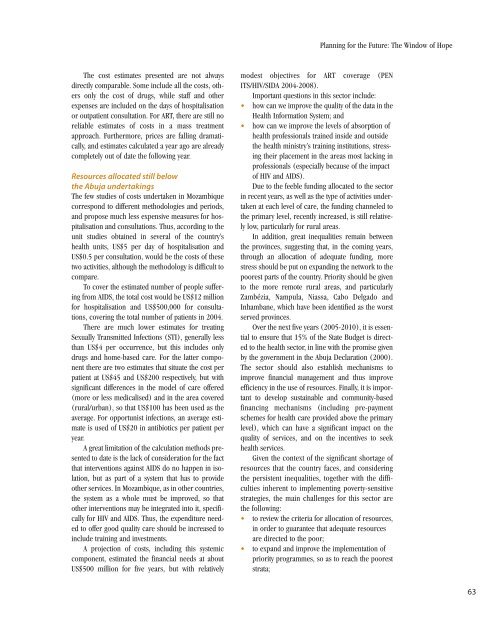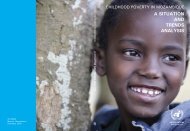English language version - Human Development Reports - United ...
English language version - Human Development Reports - United ...
English language version - Human Development Reports - United ...
- No tags were found...
Create successful ePaper yourself
Turn your PDF publications into a flip-book with our unique Google optimized e-Paper software.
Planning for the Future: The Window of HopeThe cost estimates presented are not alwaysdirectly comparable. Some include all the costs, othersonly the cost of drugs, while staff and otherexpenses are included on the days of hospitalisationor outpatient consultation. For ART, there are still noreliable estimates of costs in a mass treatmentapproach. Furthermore, prices are falling dramatically,and estimates calculated a year ago are alreadycompletely out of date the following year.Resources allocated still belowthe Abuja undertakingsThe few studies of costs undertaken in Mozambiquecorrespond to different methodologies and periods,and propose much less expensive measures for hospitalisationand consultations. Thus, according to theunit studies obtained in several of the country’shealth units, US$5 per day of hospitalisation andUS$0.5 per consultation, would be the costs of thesetwo activities, although the methodology is difficult tocompare.To cover the estimated number of people sufferingfrom AIDS, the total cost would be US$12 millionfor hospitalisation and US$500,000 for consultations,covering the total number of patients in 2004.There are much lower estimates for treatingSexually Transmitted Infections (STI), generally lessthan US$4 per occurrence, but this includes onlydrugs and home-based care. For the latter componentthere are two estimates that situate the cost perpatient at US$45 and US$200 respectively, but withsignificant differences in the model of care offered(more or less medicalised) and in the area covered(rural/urban), so that US$100 has been used as theaverage. For opportunist infections, an average estimateis used of US$20 in antibiotics per patient peryear.A great limitation of the calculation methods presentedto date is the lack of consideration for the factthat interventions against AIDS do no happen in isolation,but as part of a system that has to provideother services. In Mozambique, as in other countries,the system as a whole must be improved, so thatother interventions may be integrated into it, specificallyfor HIV and AIDS. Thus, the expenditure neededto offer good quality care should be increased toinclude training and investments.A projection of costs, including this systemiccomponent, estimated the financial needs at aboutUS$500 million for five years, but with relativelymodest objectives for ART coverage (PENITS/HIV/SIDA 2004-2008).Important questions in this sector include:• how can we improve the quality of the data in theHealth Information System; and• how can we improve the levels of absorption ofhealth professionals trained inside and outsidethe health ministry’s training institutions, stressingtheir placement in the areas most lacking inprofessionals (especially because of the impactof HIV and AIDS).Due to the feeble funding allocated to the sectorin recent years, as well as the type of activities undertakenat each level of care, the funding channeled tothe primary level, recently increased, is still relativelylow, particularly for rural areas.In addition, great inequalities remain betweenthe provinces, suggesting that, in the coming years,through an allocation of adequate funding, morestress should be put on expanding the network to thepoorest parts of the country. Priority should be givento the more remote rural areas, and particularlyZambézia, Nampula, Niassa, Cabo Delgado andInhambane, which have been identified as the worstserved provinces.Over the next five years (2005-2010), it is essentialto ensure that 15% of the State Budget is directedto the health sector, in line with the promise givenby the government in the Abuja Declaration (2000).The sector should also establish mechanisms toimprove financial management and thus improveefficiency in the use of resources. Finally, it is importantto develop sustainable and community-basedfinancing mechanisms (including pre-paymentschemes for health care provided above the primarylevel), which can have a significant impact on thequality of services, and on the incentives to seekhealth services.Given the context of the significant shortage ofresources that the country faces, and consideringthe persistent inequalities, together with the difficultiesinherent to implementing poverty-sensitivestrategies, the main challenges for this sector arethe following:• to review the criteria for allocation of resources,in order to guarantee that adequate resourcesare directed to the poor;• to expand and improve the implementation ofpriority programmes, so as to reach the pooreststrata;63
















